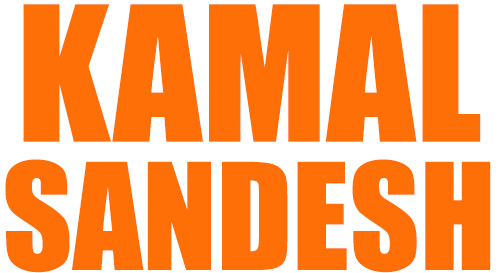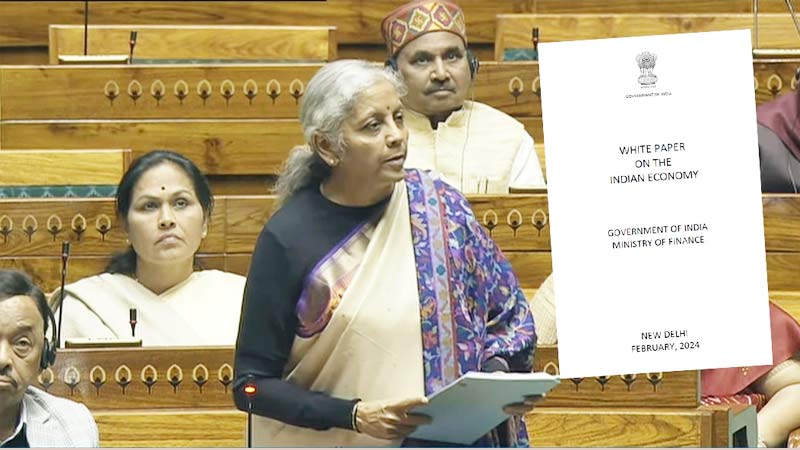In 2014 when the BJP-led NDA formed the government, the economy was in a fragile state; public finances were in bad shape; there was economic mismanagement and financial indiscipline, and there was widespread corruption. It was a crisis situation left behind as a legacy by the UPA Government. However, during the BJP-led NDA Government, every challenge of the pre-2014 era was overcome through economic management and good governance. Now under the dynamic leadership of PM Shri Narendra Modi, the NDA has placed the country on a resolute path of sustained high growth. This has been possible through the right policies, true intentions, and appropriate decisions.
This “White Paper” seeks to apprise the Members of the Parliament and the people of India, of the nature and extent of governance, economic and fiscal crises that were bequeathed on this NDA government when it assumed office in 2014, and measures that the BJP-led NDA government took to restore the health of the economy and make it vigorous and capable of fulfilling the growth aspirations of the people in the ‘Amrit Kaal’. Following are the excerpts of the “White Paper”:
Despite inheriting a thriving economy with a growth rate of 8%, the UPA government struggled to sustain momentum, leading India towards a ‘fragile-five economy’.
- Under the UPA, a major concern was the legacy of a banking crisis that witnessed a substantial increase in loans from Rs. 6.6 lakh crore in March 2004 to Rs. 39 lakh crore by March 2012. Further, the consistently high fiscal deficit, hovering above 4.5% of GDP for six consecutive years (FY09 to FY14), impacted the overall economic health. The government’s reliance on market borrowings hindered capital expenditure, with the share of capital expenditure as a total expenditure dropping from 31% in FY04 to 16% in FY14.
- Similarly, forex reserves saw a decline from approximately USD 294 billion in July 2011 to about USD 256 billion in August 2013, barely covering slightly over 6 months of imports by September 2013.
- The UPA further misused the Global Financial Crisis to justify excessive revenue expenditure, primarily for political purposes. In ten years of UPA administration, only 16,000 kilometres of National Highways were added further highlighting the lack of willingness to infrastructural development.
- Strict coastal regulations imposed by the UPA government stifled economic growth and development in 83 coastal districts. Additionally, major scandals, such as the 2G spectrum scam and the coal gate scam, created an environment of heightened political uncertainty and adversely impacted India’s reputation as an investment destination.
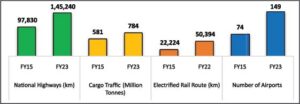
- The UPA government faced criticism for the delay in implementing the Goods and Services Tax (GST), hindering the vision of a unified market. Additionally, Aadhar, introduced in 2006, struggled with inter-ministerial differences and lacked a common purpose, failing to achieve its intended purpose.
- The UPA decade is often characterised as a lost one, as it missed the opportunity to build upon the strong foundational economy and reforms initiated by the Vajpayee government.
- Inefficient policy planning during the UPA years left Rs. 94,060 crore unspent in 14 major social and rural sector ministries from 2004 to 2014. In contrast, under the Modi government, from 2014 to 2024, only Rs. 37,064 crore, which was less than 1% of the cumulative budget estimate, remained unutilised.
- There was widespread corruption under the UPA government, spanning from the coal block allocation scam, Commonwealth scam, 2G Scam, and Antrix-Devas Deal to the Saradha Chit Fund scam. Instead of prioritising development, the UPA government seemed to implicate every sector in corruption, leaving no area untouched!
- The Modi Government’s era is marked by achievements such as eradicating open defecation, successfully vaccinating the entire eligible population with indigenous vaccines, and spearheading the digital revolution, in contrast to the perceived inefficiencies and piecemeal delivery of the UPA regime that led India to become a fragile five economy.
- The transformative approach by the Modi Government brought India to the League of the Top Five in just a decade and is now on the path to becoming the third-largest economy by 2027.
- The UPA’s mishandling of the macroeconomy is evident by the negative current account balance as a % of GDP of -4.8 in 2013-14 and sluggish Y-o-Y GDP growth of 5.5 compared to the Modi government’s GDP growth of 9.1 in 2021-22.
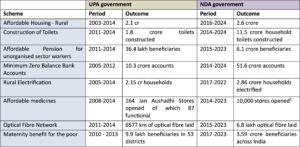
- Under the Modi Government, capital expenditure rose to 28% in FY24 from 16% in FY14. UPA’s negligence left national highway construction at a mere 12 Km/day in FY15, while under the Modi government, it rose by more than 2.3X to 28 km/day in FY23. The cargo traffic at major ports has risen from 581 MT to 784 MT, while electrified rail routes and the number of airports have doubled from FY15 to FY22.
- The Modi government has adopted the philosophy “sabka sath, sabka vikas” in the true sense:
While the UPA Government constructed only 1.8 crore toilets from 2011-2014, the Modi government built a remarkable 11.5 crore household toilets from 2014-2024. Minimum Zero Balance Bank Accounts increased 500 times from 2005-12 to 2014-2024.
The UPA government merely opened 164 Jan Aushadhi stores, of which only 87 were functional. However under the Modi government, there was a phenomenal expansion to 10,000 Jan Aushadhi stores from 2014-2023.
- The average headline inflation decreased to 5% in FY14 – FY23 from 8.2% in FY04 – FY14. India’s service sector has seen a growth of 97% during the Modi Government tenure, compared to world services export of 36%, showcasing India’s world leadership in the sector.
- Indian foreign direct investment has also almost doubled between FY15 and FY23, enabled by strategic liberalisation through PLI that allowed 100% FDI through automatic routes to several sectors.
- The Modi Government successfully implemented the GST, resolving the UPA government’s decade-long struggle. The Modi Government’s commitment to cooperative federalism is evident in the devolution share increase from 30-32% to 41-42%. The absolute quantum of resources devoted to States increased almost four times, translating to approximately 1% of GDP.
- India achieved a historic record coal production level of 893.19 million tonnes in FY23, and overall coal production has grown about 57.8% compared to FY14.
- Under the Modi Government, the Gross Non-Performing Assets for public sector banks dropped to 3.2% in September 2023, while the Return on Asset increased from 0.50% in 2013-14 to 0.79% in 2022-23, and the Return on Equity increased to 12.35%.
- India has made remarkable strides from the era of scandals and limited access to modern technologies to a landscape of extensive 4G coverage at affordable rates and the world’s fastest 5G rollout in 2023. Similarly, the country has transitioned from opaque practices in resource allocation, exemplified by the Coalgate scandal, to transparent and objective auction systems aimed at bolstering the economy and public finances. Additionally, the shift from providing exclusive gold import licences to establishing a transparent bullion exchange in GIFT IFSC signifies India’s commitment to fostering fair and accessible economic platforms for all.
The Economy In 2014 – An Inheritance Of Loss
- In 2004, the economy grew at 8% and was described as ‘in a resilient mode in terms of growth, inflation, and balance of payments’. The UPA government in 2004 inherited this healthy economy which could have led to potential reforms; however, they ensured that it remained non-performing for the next 10 years.
- Between 2004 – 2008, the economy experienced rapid growth because of the reforms carried out by the then Vajpayee led NDA and favourable global conditions. Although the UPA government did not shy away from claiming credit for the high growth during this period, it failed to sustain it over the long term.
- While boasting about the 1991 reforms, the UPA undermined several macroeconomic foundations post-2008 by engaging in profound mismanagement and indifference.
- The UPA regime under the Congress government could not control price stability leading to double-digit inflation peaking at 12.3% in 2009-10, while the average inflation rate between 2004 – 2014 was 8.2%.
- During the end of the NDA-I, the Gross Non-Performing Assets (GNPA) ratio in Public Sector banks was 7.8%. After UPA’s tenure, the GNPA in September 2013 had climbed to 12.3%.
- The UPA government left a legacy of the banking crisis in the country. While they inherited public sector banks with loans of Rs. 6.6 lakh crore, by March 2012, these had already increased to Rs. 39 lakh crore. The former RBI governor himself has asserted that most of the bad loans had originated during 2006 – 2008.
- Throughout the UPA government’s tenure, External Commercial Borrowings (ECB) grew at a CAGR of 21.1%, leading to the Indian currency being vulnerable. So bad was the situation that the Forex reserve to external debt ratio tanked from 95.8 % in FY11 to 68.8 % in FY14.
- However, in the subsequent nine years, from FY14 to FY23, the growth rate of the ECB slowed to an annual rate of 4.5% and through other financial methods, Indian currency and forex reserves were strengthened.
- The UPA Government’s response to the 2008 Global Financial Crisis (a fiscal stimulus package) was a worse problem than the one it intended to address. The scale of the stimulus package exceeded the Union Government’s financial capacity and sustainability.
- During the UPA government’s six consecutive years from FY09 to FY14, India’s Gross Fiscal Deficit (GFD) to Gross Domestic Product (GDP) ratio consistently remained at a minimum of 4.5%. Further the Kelkar committee report, constituted by the UPA itself, highlighted the underlying deficit being higher than the budgeted deficit.
- Because of extensive borrowings from the market, the UPA had to prioritise interest payments and could not focus on capital expenditure. Capital expenditure as a total expenditure (excluding interest payments) halved from 31% in FY04 to 16% in FY14.
- The UPA government acknowledged its shortcomings in infrastructure development, informing that in the ten years of administration, only about 16,000 Km of National Highways were constructed.
- Ineffective policy planning and execution during the UPA years led to significant unutilised funds in various social sector schemes, undermining the efficiency of government initiatives. Across 14 major social and rural sector ministries, a total of Rs. 94,060 crore in budgeted expenditure remained unspent during the UPA Government’s tenure from 2004 to 2014. In contrast, under the Modi government, from 2014 to 2024, Rs. 37,064 crore, a mere 1% of cumulative budgeted expenditure, was left unspent.
- During the UPA government’s tenure, healthcare expenses remained a major concern for Indian households. Out-of-pocket expenditure accounted for 64.2% of the total health expenditure in India in FY14, showing only a slight improvement from the 69.4% OOPE recorded in FY05.
- The RBI’s April 2009 report highlighted a notable rise in Government Final Consumption Expenditure (GFCE) during the third quarter of 2008-09. This increase was attributed to various factors, including the Sixth Pay Commission payout, agricultural debt waiver, oil and fertiliser subsidies, and counter-cyclical fiscal measures. Importantly, a significant portion of this expenditure
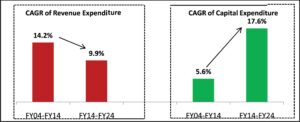
In absolute numbers, the budgeted capital expenditure has increased overfive-folds from FY14 to FY24 (RE), without any heating-up of the economy.
- expansion took place before the Global Financial Crisis. This underscores how the UPA government leveraged the financial crisis to justify excessive revenue expenditure, primarily for political purposes, without delivering significant economic benefits to society.
- The UPA government’s policy paralysis hindered long-term national development, particularly in defence preparedness, leading to prolonged delays in procuring fighter aircraft and essential gear for Indian Army soldiers. Additionally, strict regulations on industrial development in coastal districts stifled economic growth across 83 areas, paralysing the tourism sector and limiting options for economic expansion due to Coastal Regulation Zone (CRZ) norms.
Pervasive Corruption
- There was pervasive corruption under the UPA government in various activities, including procurement, allocation of natural resources, and regulatory approvals. Procurements vital for the nation’s security were also not free from corruption. The scams and corruption cases had shaken the confidence of the people. Following is the current status of some of the high-profile cases
- Coal Block Allocation: This financial scandal involved irregularities and corruption in the allocation of coal blocks by the UPA government to private companies for captive use, leading to an estimated loss of Rs. 1.86 lakh crore to the exchequer, as estimated by the CAG. Final Reports have been filed in the Courts in 47 Cases, and 10 cases are under investigation. In 14 cases the accused have been convicted by the trial courts. The remaining cases are under trial.
- Commonwealth Games: The event was marred by widespread corruption, mismanagement, and financial irregularities in the planning and execution of various projects related to the games under the UPA Government. Chargesheets were filed in 8 cases which are under trial in the courts of Delhi.
- 2G Telecom: The very well-known scam under the UPA Government involved a loss of about Rs. 1.76 lakh crore of potential revenue to the government, as estimated by the CAG (at the rates paid for 3G spectrum). The corruption cases are in the appellate court.
- Saradha Chit Fund: This was a Ponzi scheme with the diversion of funds for personal use and luring investors with the promise of high returns. The scam unfolded in 2013 under the corrupt UPA Government when the group collapsed, leaving millions of investors in financial distress.
- Antrix-Devas Deal: The UPA government was involved in a controversy involving irregularities and corruption in a satellite deal between Antrix Corporation, the commercial arm of the Indian Space Research Organisation (ISRO), and Devas Multimedia Pvt. Ltd. The case also highlighted irregularities in the allocation of scarce S-band spectrum, resulting in wrongful gains for Devas Multimedia. The Supreme Court has substantiated the findings of fraud in this matter, and a charge sheet for the criminal offence has been filed.
- Allotment/Release of Prime Land in Panchkula and Gurgaon: During the UPA regime, multiple cases relating to the release of prime land from acquisition in connivance with the private builders and allotment of industrial land to close associates surfaced. After investigation, chargesheets have been filed in trial courts.
- J&K Cricket Association: The case involves the misappropriation of nearly Rs. 44 crore by opening “bogus” bank accounts, which is a common thing under the UPA Government. After investigation, a charge sheet has been filed.
- The Embraer Deal: The case is related to corruption, bribery and kickbacks in the purchase of aircraft, which had become the business under the UPA Government from the Brazilian aerospace company Embraer. After investigation, a charge sheet was filed, and the case is pending in trial court.
- Pilatus Basic Trainer Aircraft: The UPA government faced allegations of corruption in the procurement of 75 Pilatus basic trainer aircraft for the Indian Air Force in 2009.
- Hawk Aircraft Purchase: The involvement of the UPA Government in the case concerning payment of bribery to unknown officers of the Ministry of Defence during the period 2003–2012 in the procurement of Hawk Aircraft from M/s Rolls Royce plc, UK. The case is under investigation.
- Cases like INX Media Case and Aircel-Maxis, which involved money laundering and irregularities in foreign investment, are also under trial.
Rescue of the Economy from a State of Crisis, Despair and Paralysis
- The Modi Government assumed power in 2014 amidst the challenging economic landscape created by the UPA’s flawed policies, setting the nation on an uncertain path. The Modi Government rectified the economy and infused a renewed sense of dynamism and optimism through a transparent and clean governance paradigm and involving citizens in policy making.
- India has undergone a transformative journey under the Modi Government, which is a comprehensive shift from the UPA era, marked by achievements such as eradicating open defecation, successfully vaccinating the entire eligible population with indigenous vaccines, and spearheading the digital revolution, in contrast to the perceived inefficiencies and piecemeal delivery of UPA regime that led India to become a fragile five economy.
- The transformative approach by the Modi Government brought India to the League of the Top Five in just a decade and is now on the path to becoming the third-largest economy by 2027.
- The UPA’s mishandling of the macroeconomy is evident by the negative current account balance as a percentage of GDP of -4.8 in 2013-14 and sluggish Y-o-Y GDP growth of 5.5 compared to the Modi government’s GDP growth of 9.1 in 2021-22.
- Under the Modi Government, a paradigm shift in capital expenditure is evident, with its share rising to 28% in FY24 from 16% in FY14. UPA’s negligence left national highway construction at a mere 12 Km/day in FY15, a stark difference from the Modi government’s achievement, which rose by more than 2.3X to 28 km/day in FY23. The cargo traffic at major ports has risen from 581 MT to 784 MT, while electrified rail routes and airports have doubled from FY15 to FY22.
- The Modi Government’s focus on defence procurement, exemplified by fighter jet acquisition and indigenous submarine development, contrasts with the UPA era’s lack of priorities. Additionally, the introduction of the Coastal Regulation Zone (CRZ) 2019 reflects the true spirit of balancing ‘Prakriti’ and ‘Pragati’, which was wholly missing in the regulations of 2011.
- The announcement of India’s inclusion in JP Morgan’s Government Bond Index-Emerging Markets (GBI-EM) is a milestone event, showing India’s growth in the global economy. India, under the Modi Government, is now a must-have in one’s portfolio.
- The Modi government has adopted the philosophy “sabka sath, sabka vikas” prioritising universal access to basic amenities and presented a much better track record of programme delivery than its predecessor.
- While the UPA Government constructed only 1.8 crore toilets from 2011-2014, the Modi government built a remarkable 11.5 crore household toilets from 2014-2024. Minimum Zero Balance Bank Accounts increased 500 times from 2005-12 to 2014-2024.
- The UPA government merely opened 164 Jan Aushadhi stores, of which only 87 were functional. In stark contrast, the Modi government’s commitment to healthcare accessibility is evident, which saw a phenomenal expansion to 10,000 Jan Aushadhi stores from 2014-2023.
- The Modi Government used technology, and the JAM Trinity has revolutionised governance, addressing execution challenges that plagued the UPA era. Through initiatives like JAM-PAHAL and transparent monitoring, leakages in LPG subsidies were reduced by 24%. The Modi government’s commitment to “reaching the last mile” is evident in Aadhaar-enabled DBT, transferring over Rs. 34 lakh crore to 1,167 crore beneficiaries.
- The average headline inflation decreased to 5% in FY14 – FY23 from 8.2% in FY04 – FY14 showing how the Modi Government tackled the high inflation inherited from the UPA government.
- India’s service sector has seen a growth of 97% during the Modi Government tenure, even when the world services export only grew by 36%, showcasing India’s world leadership in the sector.
- Indian foreign direct investment has almost doubled between FY15 and FY23, enabled by strategic liberalisation through PLI that allowed 100% FDI through automatic routes to several sectors. This has ensured India’s strong and safe external sector, with forex reserves extending by USD 314 billion between March 2014 and January 2024.
- The long-term economic rebuilding under the Modi Government ensured India was cushioned to global shocks like the USA’s taper tantrum of 2021-22. While under UPA Raaj in 2013, the Indian currency depreciated by 14.9% in a mere 4 months of Fed’s interest announcements, in 2021, the rupee depreciation recorded in four months of tantrum was a mere 0.7% reflecting the strong position of Indian currency.
- The Modi Government has brought down the average current account deficit significantly to 1.1 % from the UPA’s legacy of 2.3% of GDP due to the increase in merchandise export and service sector exports.
- With the implementation of GST, the Modi Government slashed more than 400 rates and commissions to bring all states and UTs under one structure. The GST implementation has led to households saving approximately Rs. 45,000 crore per month while increasing the monthly average revenue from GST for the government to Rs. 1.7 lakh crore in FY24.
The Modi Government, in the true spirit of cooperative federalism, accepted the recommendations of the 14th and 15th Finance Commission. Over the last decade, around 41-42% of Central taxes have been shared with the States, a substantial increase from the earlier devolution share of 30-32%. This has resulted in a significant leap in the absolute quantum of resources devoted to States, about 3.8 times higher than earlier, translating to approximately 1% of GDP.
Sectoral Transformation led by the Modi Government
Power
The Modi Government has effectively cleaned the coal sector through legislative reforms and liberalisations. Due to the government’s strong efforts, India achieved a historic record coal production level of 893.19 million tonnes in FY23, and overall coal production has grown about 57.8% compared to FY14.
Within a year of governance, the Modi Government ensured that no coal plant faced a coal shock, unlike how they inherited from UPA, with two-thirds of plants in critical shocks. Efforts like capacity building and One Nation One Grid One Frequency have reduced the gap between Energy Requirement and Energy Supplied from 4.2% in 2013-14 to 0.3 % in 2023-24.
In the true spirit of welfare, the Modi government has ensured electric connection and quality power availability, increasing power availability in rural areas from 12 hours in 2015 to 20.6 hours. In urban areas, we have almost reached 24 hours of power availability.
- Banking Sector
Under the Modi Government, the banking sector witnessed a commendable revival, marked by a significant drop in Gross Non-Performing Assets to 3.2% in September 2023. This contrasts starkly with the UPA era’s negligence, which left balance sheets in disarray.
The current success is evident in key ratios for public sector banks like increased Return on Asset from 0.50% in 2013-14 to 0.79% in 2022-23, and Return on Equity from 8.48% to 12.35% highlights the UPA’s failure to ensure financial health and resilience in the banking sector.Telecommunication
The Modi government has implemented substantial telecom industry changes since 2014 and improved spectrum utilisation by introducing open trading, auctioning, and sharing spectrum techniques. Furthermore, the 5G network rollout in the nation, which was globally the fastest, was made possible by enhanced cash flow for TSPs, making capital investments in 5G technology easier. Under UPA, India had a 2G scam; now, the Modi Government has ensured extensive coverage of the population under 4G with the lowest rates and the world’s fastest rollout of 5G in 2023.
